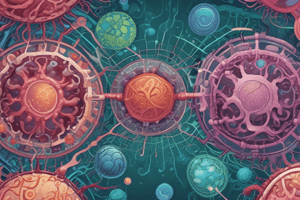Podcast
Questions and Answers
Which group of micro-organisms can be autotrophic or heterotrophic?
Which group of micro-organisms can be autotrophic or heterotrophic?
- Protists (correct)
- Bacteria
- Fungi
- Viruses
What is primarily responsible for decomposing dead organic matter in ecosystems?
What is primarily responsible for decomposing dead organic matter in ecosystems?
- Algae
- Bacteria (correct)
- Protozoa
- Viruses
Which micro-organisms are known for forming mutualistic relationships with plants and animals?
Which micro-organisms are known for forming mutualistic relationships with plants and animals?
- Fungi
- Bacteria (correct)
- Algae
- Protozoa
What is the fundamental difference between the basic structures of Protists and Fungi?
What is the fundamental difference between the basic structures of Protists and Fungi?
Which group of micro-organisms are mostly responsible for fixing atmospheric nitrogen for plant use?
Which group of micro-organisms are mostly responsible for fixing atmospheric nitrogen for plant use?
What is a common method of reproduction in Protists?
What is a common method of reproduction in Protists?
What distinguishes the nutritional mode of Protists from Fungi?
What distinguishes the nutritional mode of Protists from Fungi?
Which form of movement is common among Protists?
Which form of movement is common among Protists?
What role do bacteria and fungi play in ecosystems?
What role do bacteria and fungi play in ecosystems?
Which micro-organisms are essential components of the nitrogen cycle?
Which micro-organisms are essential components of the nitrogen cycle?
What is the main difference in structure between viruses and bacteria?
What is the main difference in structure between viruses and bacteria?
Which characteristic is unique to viruses?
Which characteristic is unique to viruses?
In terms of size, how do viruses compare to bacteria?
In terms of size, how do viruses compare to bacteria?
Which of the following statements is true about virus reproduction?
Which of the following statements is true about virus reproduction?
What is a fundamental difference in the nature of viruses and bacteria?
What is a fundamental difference in the nature of viruses and bacteria?
Which of the following is NOT a characteristic shared by viruses and bacteria?
Which of the following is NOT a characteristic shared by viruses and bacteria?
Which cellular feature is present in bacteria but absent in viruses?
Which cellular feature is present in bacteria but absent in viruses?
What distinguishes the sizes of viruses and bacteria?
What distinguishes the sizes of viruses and bacteria?
What type of organism is unable to perform metabolic processes independently?
What type of organism is unable to perform metabolic processes independently?
Which type of microorganism exhibits characteristics of both living and non-living things?
Which type of microorganism exhibits characteristics of both living and non-living things?
What is the typical size range of viruses?
What is the typical size range of viruses?
Which type of organism primarily reproduces through binary fission?
Which type of organism primarily reproduces through binary fission?
Which type of organism possesses a protein coat called a capsid?
Which type of organism possesses a protein coat called a capsid?
Which type of organism can become dormant outside host cells?
Which type of organism can become dormant outside host cells?
Which type of organism can be autotrophic or heterotrophic?
Which type of organism can be autotrophic or heterotrophic?
Which type of organism is an obligate parasite requiring a host for replication?
Which type of organism is an obligate parasite requiring a host for replication?
Which type of organism typically possesses flagella for movement?
Which type of organism typically possesses flagella for movement?
Which type of organism is commonly responsible for causing diseases in various organisms including humans?
Which type of organism is commonly responsible for causing diseases in various organisms including humans?
What is a distinguishing feature of Fungi's cell structure?
What is a distinguishing feature of Fungi's cell structure?
Which group of micro-organisms can exhibit movement through cilia, flagella, or pseudopodia?
Which group of micro-organisms can exhibit movement through cilia, flagella, or pseudopodia?
What type of reproduction is common among Fungi?
What type of reproduction is common among Fungi?
Which micro-organisms are producers in food chains by synthesizing their own food via photosynthesis?
Which micro-organisms are producers in food chains by synthesizing their own food via photosynthesis?
What is the primary nutritional mode of Fungi?
What is the primary nutritional mode of Fungi?
Which micro-organisms play essential roles in decomposing dead organisms in ecosystems?
Which micro-organisms play essential roles in decomposing dead organisms in ecosystems?
In what way do bacteria contribute to the nitrogen cycle?
In what way do bacteria contribute to the nitrogen cycle?
Which group of micro-organisms forms mutualistic relationships with plants and animals?
Which group of micro-organisms forms mutualistic relationships with plants and animals?
What distinguishes Protists from Fungi in terms of basic structure?
What distinguishes Protists from Fungi in terms of basic structure?
What is a key difference between the nutritional modes of Protists and Fungi?
What is a key difference between the nutritional modes of Protists and Fungi?
What distinguishes the reproductive capabilities of Protists from Fungi?
What distinguishes the reproductive capabilities of Protists from Fungi?
Which group of micro-organisms plays a critical role in the nitrogen cycle by fixing atmospheric nitrogen into usable forms for plants?
Which group of micro-organisms plays a critical role in the nitrogen cycle by fixing atmospheric nitrogen into usable forms for plants?
In terms of habitat, where are most Protists found?
In terms of habitat, where are most Protists found?
Which factor primarily differentiates the cell walls of Protists and Fungi?
Which factor primarily differentiates the cell walls of Protists and Fungi?
What is a common method of movement among Protists?
What is a common method of movement among Protists?
What primarily distinguishes the nutritional mode of Protists from Fungi?
What primarily distinguishes the nutritional mode of Protists from Fungi?
Which ecological role is NOT typically associated with micro-organisms like bacteria and fungi?
Which ecological role is NOT typically associated with micro-organisms like bacteria and fungi?
Which type of microorganism can exhibit movement through cilia, flagella, or pseudopodia?
Which type of microorganism can exhibit movement through cilia, flagella, or pseudopodia?
Which group of micro-organisms forms mutualistic relationships with plants and animals?
Which group of micro-organisms forms mutualistic relationships with plants and animals?
Which type of organism can be autotrophic or heterotrophic?
Which type of organism can be autotrophic or heterotrophic?
Which group of micro-organisms are mostly responsible for fixing atmospheric nitrogen for plant use?
Which group of micro-organisms are mostly responsible for fixing atmospheric nitrogen for plant use?
What is a fundamental difference in the nature of viruses and bacteria?
What is a fundamental difference in the nature of viruses and bacteria?
Which form of movement is common among Protists?
Which form of movement is common among Protists?
What is primarily responsible for decomposing dead organic matter in ecosystems?
What is primarily responsible for decomposing dead organic matter in ecosystems?
Which micro-organisms are known for forming mutualistic relationships with plants and animals?
Which micro-organisms are known for forming mutualistic relationships with plants and animals?
In what way do bacteria contribute to the nitrogen cycle?
In what way do bacteria contribute to the nitrogen cycle?
Which characteristic is unique to viruses?
Which characteristic is unique to viruses?
Which micro-organisms are capable of sexual reproduction and can exhibit movement through pseudopodia?
Which micro-organisms are capable of sexual reproduction and can exhibit movement through pseudopodia?
Which group of micro-organisms is primarily responsible for breaking down dead organic matter through saprotrophic nutrition?
Which group of micro-organisms is primarily responsible for breaking down dead organic matter through saprotrophic nutrition?
Which micro-organisms are typically involved in mutualistic relationships with plants, enhancing host nutrition and immunity?
Which micro-organisms are typically involved in mutualistic relationships with plants, enhancing host nutrition and immunity?
Which micro-organisms play a crucial role in the nitrogen cycle by decomposing organic matter back into atmospheric nitrogen?
Which micro-organisms play a crucial role in the nitrogen cycle by decomposing organic matter back into atmospheric nitrogen?
Which micro-organisms are unicellular, and their cell walls are composed of chitin?
Which micro-organisms are unicellular, and their cell walls are composed of chitin?
Which group of micro-organisms reproduces asexually through spores and sexually through gamete fusion?
Which group of micro-organisms reproduces asexually through spores and sexually through gamete fusion?
Which micro-organisms are known to synthesize their own food through photosynthesis, forming the base of aquatic food chains?
Which micro-organisms are known to synthesize their own food through photosynthesis, forming the base of aquatic food chains?
Which micro-organisms can be found in both freshwater and marine habitats and exhibit different nutritional modes?
Which micro-organisms can be found in both freshwater and marine habitats and exhibit different nutritional modes?
Which micro-organisms are capable of both sexual and asexual reproduction and can exhibit movement through cilia or flagella?
Which micro-organisms are capable of both sexual and asexual reproduction and can exhibit movement through cilia or flagella?
Which group of micro-organisms forms mutualistic relationships with animals, enhancing host nutrition and overall health?
Which group of micro-organisms forms mutualistic relationships with animals, enhancing host nutrition and overall health?
What is the primary difference in the nature of viruses and bacteria?
What is the primary difference in the nature of viruses and bacteria?
Which of the following is NOT a characteristic shared by viruses and bacteria?
Which of the following is NOT a characteristic shared by viruses and bacteria?
What type of organism possesses a protein coat called a capsid?
What type of organism possesses a protein coat called a capsid?
Which ecological role is NOT typically associated with micro-organisms like bacteria and fungi?
Which ecological role is NOT typically associated with micro-organisms like bacteria and fungi?
What type of organism is unable to perform metabolic processes independently?
What type of organism is unable to perform metabolic processes independently?
What is the fundamental difference between the basic structures of Protists and Fungi?
What is the fundamental difference between the basic structures of Protists and Fungi?
Which of the following statements is true about virus reproduction?
Which of the following statements is true about virus reproduction?
In terms of habitat, where are most Protists found?
In terms of habitat, where are most Protists found?
Which type of organism can be autotrophic or heterotrophic?
Which type of organism can be autotrophic or heterotrophic?
What is a primary difference between the nutritional modes of Protists and Fungi?
What is a primary difference between the nutritional modes of Protists and Fungi?




